As I strummed the A sharp guitar chord for the first time, a world of musical possibilities opened before me. Little did I know that this seemingly simple chord would become a cornerstone of my musical journey. The rich, vibrant sound emanating from my guitar captivated me, igniting a passion that would span over four decades. Throughout my years as a fingerstyle guitarist, I’ve discovered that mastering the A sharp chord is like unlocking a secret door to countless melodies and progressions. Its versatility across genres, from blues to rock and beyond, never ceases to amaze me. In this comprehensive guide, I’ll share my hard-earned insights and techniques to help you conquer this essential chord. Whether you’re a beginner or an experienced player looking to refine your skills, join me as we explore the intricacies of the A sharp chord and elevate your guitar playing to new heights.
Understanding the A Sharp Chord
A Sharp vs B Flat: The Relationship

In my years of teaching and performing, I’ve noticed that the relationship between A sharp and B flat often confuses newcomers. Let me share some insights I’ve gained from my experience in both classical and contemporary guitar styles. On the guitar, A sharp and B flat are enharmonic equivalents, meaning they’re the same note but spelled differently. When playing A sharp vs B flat on guitar, your finger placement remains identical. The distinction primarily comes into play when reading sheet music or discussing music theory.
Understanding this relationship is crucial for guitarists, especially when collaborating with other musicians or transposing songs. In practice, I’ve found that most guitarists tend to think in terms of flats rather than sharps, but being comfortable with both is essential for musical fluency. This knowledge will enhance your ability to communicate effectively with other musicians and navigate various musical contexts with ease.
The Role of A Sharp in Music
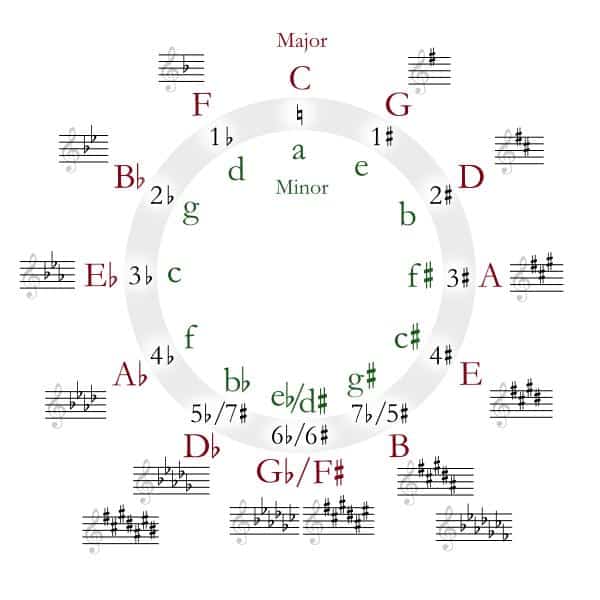
As a guitarist who’s explored various genres, I’ve come to appreciate the crucial role of A sharp in music. In the context of equal temperament guitar, A sharp serves as a pivotal note that bridges harmonic transitions and adds tonal color. My journey through folk and jazz has taught me that understanding A sharp is essential for grasping complex chord progressions and modulations. It’s not just about playing the right notes; it’s about comprehending the harmonic landscape.
In practice, A sharp often functions as a leading tone, creating tension that resolves beautifully to B. This tension-resolution dynamic is fundamental to Western music theory and plays out vividly on the fretboard. Moreover, A sharp’s enharmonic relationship with B flat opens up a world of compositional possibilities, allowing for seamless key changes and rich harmonic textures. Mastering A sharp has profoundly enhanced my musical expressiveness and improvisational skills across genres.
Playing the A Sharp Chord
Basic A Sharp Chord Finger Position

As a guitar instructor, I’ve found that mastering the A# chord finger positions is crucial for beginners. Through my years of teaching, I’ve developed a foolproof method for positioning your fingers. Start by placing your index finger on the first fret of the G string. Next, position your middle finger on the second fret of the D string. Finally, your ring finger goes on the third fret of the B string. This forms the basic A# chord shape.
I always emphasize to my students the importance of finger placement precision. Ensure each fingertip is close to the fret without touching it, and press down firmly. This prevents buzzing and produces a clear sound. Remember, consistent practice is key to developing muscle memory. With time, your fingers will naturally find their way to the correct positions, making the A# chord second nature.
A Sharp Chord Diagram
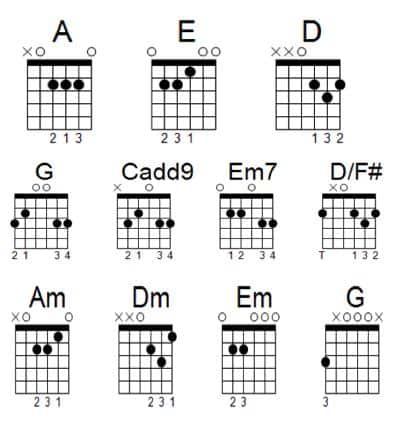
As I’ve created countless A# major chord diagrams over the years, I’ve learned that visual representation is key to mastering new chords. In this section, I’ll share a clear, easy-to-follow diagram for the A sharp chord, drawing from my teaching experience. The diagram will show the fretboard, highlighting finger placement and string involvement. I’ve found that students often benefit from color-coded fingerings, so I’ll incorporate this technique. Remember, while the diagram is a crucial learning tool, it’s equally important to feel the chord as you play it. This tactile experience, combined with the visual guide, will significantly accelerate your learning process.
Step-by-Step Tutorial
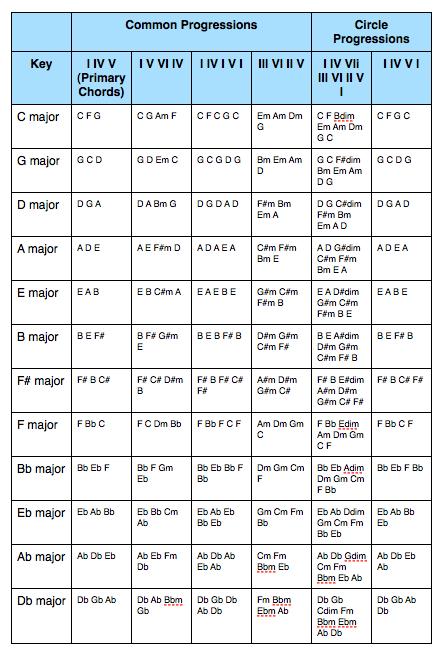
As we delve into the step-by-step tutorial for playing the A sharp chord, I’m reminded of countless guitar chord A# tutorials I’ve created over the years. Drawing from my experience in online guitar lessons, I’ll guide you through this process with the same meticulous approach I use in my video content. Let’s break it down into manageable steps.
First, position your index finger on the first fret of the C string. This forms the foundation of our A# chord. Next, place your middle finger on the second fret of the E string. Finally, your ring finger goes on the third fret of the A string. It’s crucial to apply firm pressure with each finger to avoid any muted or buzzing strings. As you strum, listen carefully to ensure each note rings out clearly.
Remember, mastering this chord takes practice. I often advise my students to transition slowly between A# and other chords, gradually building up speed. This method has consistently yielded great results, helping guitarists of all levels to confidently incorporate A# into their playing. As we move forward, we’ll explore variations of this chord to expand your musical possibilities.
A Sharp Chord Variations
A Sharp Barre Chord
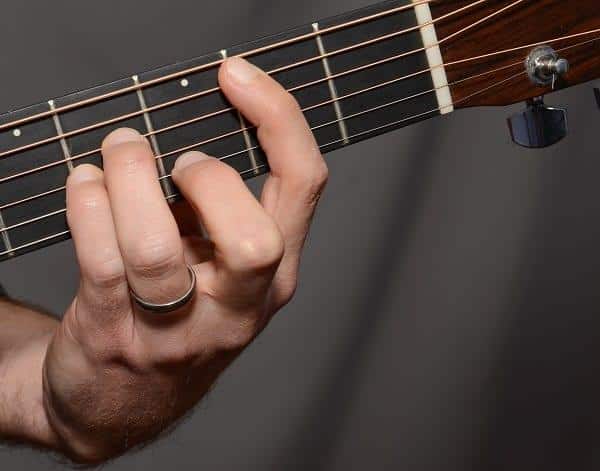
As a guitarist, I’ve found that mastering the A sharp barre chord is a game-changer. It’s a versatile variation that opens up a world of musical possibilities. The A# chord barre involves using your index finger to press down all strings at once, creating a movable shape that can be shifted up and down the fretboard. This technique allows you to play in any key without changing your hand position.
I remember struggling with barre chords early in my career, but with practice, they became second nature. The A sharp barre chord, in particular, has a rich, full-bodied sound that’s perfect for rock and blues. It’s also essential for playing in certain keys where open chords won’t suffice. By incorporating this variation into your repertoire, you’ll significantly expand your chord vocabulary and be able to tackle a wider range of songs with confidence.
Open Position A Sharp Chord

In my years of playing and composing, I’ve found that the open position A# chord offers a unique tonal quality that’s hard to replicate with other voicings. This variation adds depth and resonance to your playing, making it a valuable addition to your chord repertoire. The open strings create a fuller, more vibrant sound that can breathe new life into familiar progressions.
To play the open position A#, I typically use my index finger on the first fret of the G string, while my middle and ring fingers cover the second fret of the D and B strings respectively. The high E, A, and low E strings are left open. This fingering allows for a rich, expansive sound that’s particularly effective in folk and country styles. When I’m arranging pieces, I often use this voicing to add texture and create interesting harmonic movements, especially when transitioning between other open chords.
Practicing the A Sharp Chord
Beginner Exercises

As a longtime guitar instructor, I’ve developed beginner exercises that are crucial for mastering the A sharp chord. I always start my students with simple finger placement drills, having them practice moving between A# and other beginner chords like G and C. This builds muscle memory and dexterity. Next, I introduce strumming patterns, starting with basic downstrokes and gradually incorporating more complex rhythms. To enhance finger strength, I recommend holding the A# chord for increasing durations, aiming for 30 seconds without buzzing.
One of my favorite exercises involves playing A# in different positions on the fretboard, helping beginners understand chord shapes and fret relationships. I also encourage students to practice chord transitions, moving smoothly between A# and other chords in common progressions. These exercises lay a solid foundation for incorporating A# into songs and more advanced techniques.
Incorporating A Sharp in Songs

In my years of teaching guitar lessons, I’ve found that incorporating the A sharp chord into songs is a crucial step in mastering it. When I arrange pieces, I often look for opportunities to seamlessly blend A sharp into the progression. One effective approach is to use it as a passing chord, creating tension before resolving to the tonic. For instance, in a song in the key of F, try inserting an A# before returning to F – it adds a rich, unexpected flavor to the harmony.
I encourage my students to experiment with popular songs featuring A sharp, such as “Sweet Home Alabama” or “Free Fallin’.” Start by identifying the chord’s placement in these tracks, then practice transitioning to and from A sharp smoothly. Remember, the key is to make the chord change feel natural and effortless. With consistent practice, you’ll soon find A sharp becoming an integral part of your guitar vocabulary.
Tuning and Troubleshooting
Using a Tuner for A Sharp
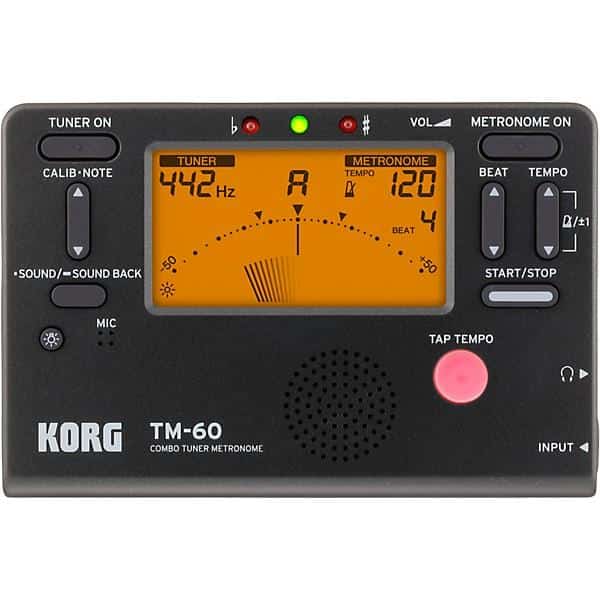
As a performer, I’ve learned that using a tuner is crucial for nailing the A# on guitar. I always keep a clip-on tuner in my gig bag, which has saved me countless times during sound checks. When tuning to A#, I start with the low E string and work my way up. I’ve found that slightly over-tightening each string and then backing off to the correct pitch yields more stable tuning. For quick on-stage adjustments, I use harmonics at the 5th and 7th frets to compare adjacent strings, a trick that’s served me well in noisy environments.
Remember, A# is enharmonic to Bb, so most tuners will display ‘A#’ or ‘Bb’ interchangeably. If you’re having trouble getting your guitar to resonate at A#, check for any physical issues like worn frets or a misaligned bridge. Proper tuning is the foundation of a great performance, and mastering it will significantly improve your overall guitar playing experience.
Common Mistakes and Solutions

In my years of teaching, I’ve encountered numerous common mistakes with the A sharp chord. One frequent issue is improper finger placement, often due to the chord’s challenging shape. I’ve found that practicing with an A# chord guitar tab can help visualize the correct positioning. Another problem is inadequate pressure on the strings, resulting in muted or buzzing notes. To address this, I encourage my students to focus on pressing down with their fingertips rather than the pads of their fingers.
Transitioning to and from the A sharp chord can also be tricky. I recommend practicing chord changes slowly, gradually increasing speed as muscle memory develops. For those struggling with hand fatigue, I suggest breaking practice sessions into shorter intervals and incorporating hand stretches. By addressing these common issues, players can significantly improve their A sharp chord technique, contributing to overall guitar mastery and musical expression.
FAQs
What is an A Sharp chord on guitar?
An A Sharp chord (A#) on guitar is a major chord that consists of the notes A#, D, and F. It’s also known as the B-flat (Bb) chord, as A# and Bb are enharmonic equivalents.
How do you play the A Sharp chord on guitar?
To play the A Sharp chord:
1. Place your index finger on the 1st fret of the A string
2. Put your middle finger on the 2nd fret of the D string
3. Position your ring finger on the 3rd fret of the G string
4. Strum from the A string downward
Why is mastering the A Sharp chord important?
Mastering the A Sharp chord is important because:
1. It’s used in many popular songs across various genres
2. It helps in understanding music theory and chord progressions
3. It improves finger dexterity and hand strength
4. It allows for greater versatility in your playing
What are some tips for practicing the A Sharp chord?
Tips for practicing the A Sharp chord include:
1. Start slowly and focus on proper finger placement
2. Practice transitioning to and from other chords
3. Use a metronome to improve timing and rhythm
4. Incorporate the chord into simple songs or progressions
5. Practice regularly, even if only for short periods
Are there alternative ways to play the A Sharp chord?
Yes, there are alternative ways to play the A Sharp chord:
1. Barre chord: Use your index finger to bar the 1st fret and form an A shape with your other fingers
2. Power chord: Play only the root and fifth (1st fret on A string, 3rd fret on D string)
3. Higher up the neck: Play the same shape starting from the 6th fret on the low E string
Conclusion
How will mastering the A sharp guitar chord transform your guitar playing? Let’s reflect on your journey and look ahead to new musical horizons. As we’ve explored throughout this guide, the A sharp chord is a fundamental building block in guitar mastery. From my decades of experience, I can assure you that investing time in perfecting this chord will pay dividends in your musical journey.
Remember, the A sharp chord isn’t just about finger placement; it’s about unlocking new musical possibilities. Whether you’re strumming open chords or tackling complex barre shapes, your newfound proficiency will enhance your overall playing. As you continue to practice, you’ll find that the A sharp chord becomes second nature, allowing you to focus on expression and creativity.
I encourage you to keep pushing your boundaries. Incorporate the A sharp chord into your favorite songs, experiment with variations, and most importantly, enjoy the process. Your dedication to mastering this chord is a testament to your growth as a guitarist. Here’s to your continued success and the beautiful music you’ll create!